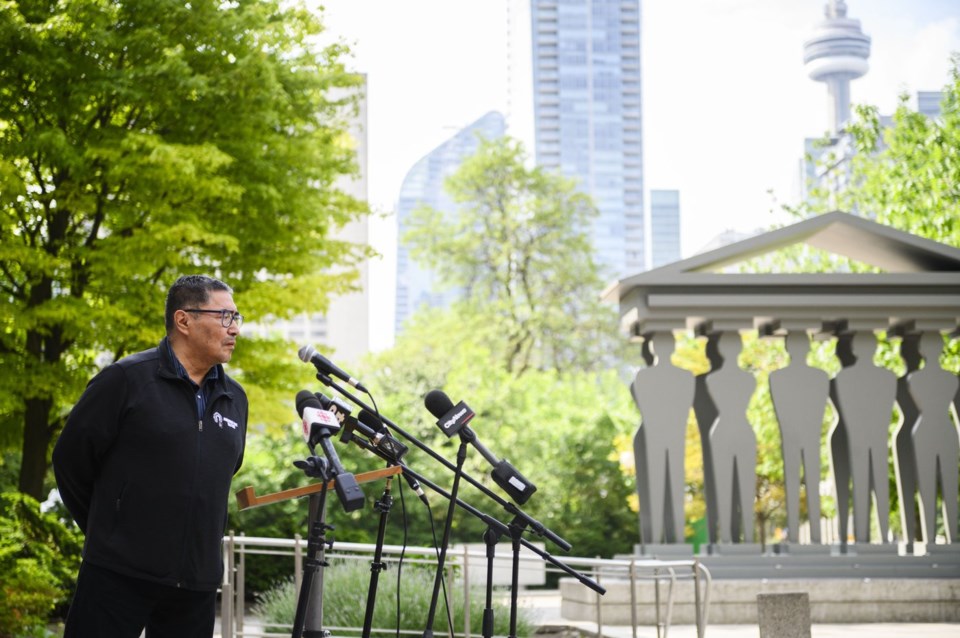TORONTO — A northern Ontario First Nation that has been plagued by mercury poisoning for decades said Tuesday it is suing the governments of Ontario and Canada over mercury contamination in a river system that flows through its territory.
Grassy Narrows First Nation alleges the governments breached their obligations by failing to ensure the community could safely practise its right to fish.
The lawsuit alleges the governments first allowed the English-Wabigoon river system to be contaminated, then failed to remediate it, all while authorizing industrial activities that worsened the harm.
Mercury is harmful to humans who eat contaminated fish, and the people of Grassy Narrows fish to eat, earn a livelihood and maintain their way of life, according to the statement of claim.
Speaking on the steps of a downtown Toronto courthouse Tuesday, Grassy Narrows Chief Rudy Turtle said he believes the issue would have been handled very differently if it had affected a different region and population.
"We're not looked at as important because there's very few of us," he said of the community, of which roughly 1,000 members live on reserve.
It has come to a point where legal action is necessary, he added.
"We are doing this for our children, our grandchildren. There's a new generation of young people that are being born every day. And they are being born to a contaminated river with contaminated fish," the chief said.
The lawsuit is seeking, among other things, an order that the governments remediate and protect the river and Grassy Narrows territory, and prohibit the authorization of industrial land use in or near the territory that would infringe on treaty rights.
Adrienne Telford, one of the lawyers representing the First Nation in the lawsuit, said that includes asking the Crown to stop allowing a mill upstream of the community to allegedly contaminate the environment and cause harm.
"We believe that the Crown should have to prove or be able to guarantee that the mill is not causing harm in order for it to operate," she said.
Grassy Narrows said a statement of claim was served to the governments Tuesday.
None of the allegations have been tested in court and the province did not immediately respond to a request for comment.
In a joint statement, federal Indigenous Services Minister Patty Hajdu and Environment Minister Steven Guilbeault said they cannot comment on a matter that is before the courts.
The written statement added it is "extremely important" to the federal government that it do its part in responding to this crisis and Ottawa will "be there to work with Grassy Narrows and Wabaseemong Independent Nations every step of the way."
"Everyone deserves to live in a healthy and safe environment, including Indigenous Peoples whose communities are too often located downwind, downstream, and next to polluting industrial facilities," the ministers said.
They said the government will fully fund a centre to care for those with mercury poisoning and have announced $146 million for its construction and operation. "We are finalizing the last details so that the construction can start shortly," they said.
The legal action comes on the heels of a study that suggested discharge from a paper mill upstream of the community is exacerbating mercury contamination that dates back decades.
Researchers behind the study said that while the Dryden, Ont., mill's wastewater doesn't contain mercury, the combination of sulphate and organic matter in it contribute to the elevated production of methylmercury – the most toxic form of the contaminant.
The levels of methylmercury in the river's fish may be twice as high as they would be without the mill discharge, they said.
The community's water was contaminated when the mill dumped 9,000 kilograms of mercury into the English-Wabigoon River system in the 1960s. The mill stopped using mercury in its industrial process in the 1970s, but mercury levels downstream of the plant have not significantly decreased since the 1980s.
When the study was released last month, a spokesman for the Ontario Ministry of Environment, Conservation and Parks said the government would continue to work with the mill owner and Indigenous communities affected by mercury contamination in the area.
The lawsuit is the first that Grassy Narrows has launched in several decades regarding the mercury problem and the infringement of its treaty rights, Telford said.
"It's the first litigation that they've launched to address in a comprehensive manner the harms, the collective harms, that their community has experienced, not just from the mercury but the ongoing contamination that is happening right now from the Dryden mill, as well as the other industrial extraction and degradation of their territory and their lands, their waters that has been ongoing for several decades now," she said.
The statement of claim alleges the governments have also authorized or regulated other industrial and land use that has negatively affected the First Nation, including logging, mining, dams and potential nuclear waste disposal sites.
Grassy Narrows has been able to secure some commitments from the government in the past, "but frankly, they're just bread crumbs," Telford said.
"So this litigation seeks to finally asked the court to intervene, to correct the Crown's bad behaviour, and to finally compensate Grassy Narrows for all the harms that has happened to them, and also to give them some measure of control and ability to protect their territory and protect their people and restore their way of life."
This report by The Canadian Press was first published June 4, 2024.
Paola Loriggio, The Canadian Press

